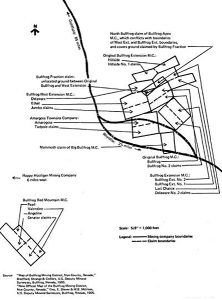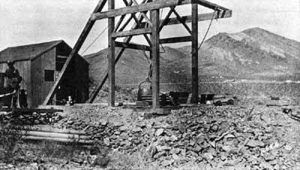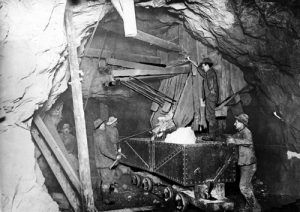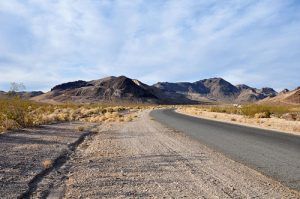One of the first rules of the mining game is to get in on the “ground floor” to make money. When possible, an experienced prospector would hurry to the scene of the latest strike, locate ground as close as possible to a strike, and form a company with a similar-sounding name.
Between 1905 and 1910, this game was played to perfection by several miners and promoters in the Bullfrog District, as 90 companies were incorporated with the magic word “Bullfrog” somewhere on their letterheads. A few of these companies were in the vicinity of the Original Bullfrog, and most, but not all, were within the boundaries of the Bullfrog District. All hoped to lure stockholders’ funds by advertising their proximity to the big strike.
Big Bullfrog Mining Company – Located south of the Original Bullfrog Mine, the Big Bullfrog was started in August 1904 when Montillus “Old Man” Beatty, a local small-time dry rancher for whom the town of Beatty was named, located the Mammoth claim.
Beatty soon sold out to a group of San Francisco financiers, who incorporated the Big Bullfrog Mining Company in 1905. Though the company owned just one claim, it formed the usual organization, with 1,000,000 shares of stock, and development began. By the end of the year, it boasted a 16-horsepower hoisting engine and a 2-horsepower blower engine for ventilating its 120-foot shaft. The company was described as “exhibiting good ore” in a Rhyolite newspaper.
Developments continued on an optimistic level in early 1906, as the company succeeded in finding some ore that assayed as high as $180 per ton. In March, the company announced that it had uncovered a body ore worth $14 a ton, and excitement mounted as it was enough to make the Big Bullfrog a paying proposition. However, an earthquake in San Francisco, California, occurred the next month, and the superintendent halted work at the mine. It did not resume operation until the middle of September. The company then reported that “satisfactory progress” was being made through the rest of the year, and no more ore bodies were found. By March 1907, they had still not located any more ore, and stock prices began to plummet. After 1908, there was no further word from the failed venture.
Bullfrog Apex Mining and Milling Company – Incorporated on August 4, 1905, by a group of promoters headed by J.J. Fagan and E.L. Andrews, the company promoted itself as the owner of 15 claims, only one of which was ever worked — the North Bullfrog. But there was a problem with the North Bullfrog claim, as it intruded into the Delaware claim of the West Extension Company. Though the Apex Company knew about these conflicting boundaries when the North Bullfrog claim was filed, they forged ahead anyway. Work on the Apex ground started in the fall of 1905.
In a race with nearby competitors, the Apex encountered encouraging ore grades, and stock sales were adequate. Confident in their claims, the promoters decided to apply for a patent, which led the West Extension Company to file a lawsuit against Apex. Although the dispute was tied up in court, both companies continued to develop shafts and tunnels. But when the Apex Company uncovered a vein of gold assaying $251 to the ton, the question was settled, and the legal battle intensified. Amid the legal battles, Apex suffered in the stock market, and by May 1906, its stock had fallen off the trading board. In the end, the Apex company lost its contest on the disputed ground and soon went out of business.
Bullfrog Extension Mining Company – On August 25 and 16, 1904, a group of prospectors located two claims, the Delaware #2 and the Last Chance, on the north and east sides of the Original Bullfrog Mine. Together with the Bullfrog Extension #1 and #2, on the southeast of the Original Bullfrog, these four locations were incorporated in February 1905 as the Bullfrog Extension Mining Company. Backed by San Francisco financiers, the company had enough money to begin mining in May 1905. Getting to work, a six-man crew soon sank an inclined shaft 75 feet deep, and the company purchased new equipment and built a frame office building. By January 1906, the company felt confident enough to advertise that it had a “magnificent quartz” ledge on its property, which was “conservatively estimated” at $500,000. However, a few months later, the promising developments were halted by the San Francisco earthquake and fire in mid-April 1906. The mine was shut down and was idle until June.
That same month, the company’s stock was at an all-time high, but for unknown reasons, it closed again, and mining resumed only in late October. By the end of 1906, although the company was still delving for ore, no significant discoveries had been made. Developments continued during the first part of 1907 as the company vainly sought traces of the Bullfrog ore on its property. Though prospects initially looked good, they still didn’t find any rich ore, and later that year they suffered the Panic of 1907, which sent their stock to an all-time low. The mine lay idle throughout 1908, but by 1909, money had been raised, and one last attempt was made to revive the fortunes of the Bullfrog Extension. Unable to raise enough money to operate independently, they advertised for lessees in June. Successfully attracting a lessee, the new promoters once again marketed the operations to potential investors, but they were unsuccessful, and the property remained idle throughout 1910. By September 1911, the company had finally given up hope. The gas hoist and gallows frame were dismantled from the Bullfrog Extension property and shipped to Rawhide for installation on a promising mine in that district.
Bullfrog Fraction – In December 1904, Len P. McGarry, mining promoter, stock dealer, and president of the Bullfrog West Extension Mining Company, noticed that the ground claimed by his company did not coincide with the boundaries of the Original Bullfrog. Between the Bullfrog claim of the Original Bullfrog company and the Delaware and Ethel claims of the West Extension lay a parcel of unclaimed land, 1.7 acres. McGarry immediately located and recorded this ground as the Bullfrog Fraction claim. Then, interestingly enough, he sold it to outside mining promoters instead of selling or deeding it to his own company. However, the new owners had hardly started working when the owners of the Bullfrog Apex Mining Company disputed their claim. Soon, the acreage was tied up in lawsuits. The Rhyolite Herald correctly surmised that the struggle would be lengthy and costly for all concerned and said. “If they fight it out, someone is bound to lose, while all will be at great expense. Think it over, gentlemen, think it over.”
The gentlemen involved, however, had already thought it over, and the Bullfrog Fraction continued to develop their claim, finding several good ore leads. As their claims grew more valuable and the court battles more complex and expensive, it became clear to them that they could no longer protect their claims on their own. So, in November 1906, they gave up and sold the Bullfrog Fraction to the West Extension Company, which quickly incorporated it into its own operations, ending the Bullfrog Fraction’s life.
Bullfrog Red Mountain/Rholite-Bullfrog – Having even less of a claim to the magic Bullfrog name, its four claims were situated almost a mile southwest of the Original Bullfrog. However, the company was organized in early 1905 and began operations, reporting that it had found ore worth $47 per ton. Despite their claim, efforts to develop the mine were not successful. By the time the Red Mountain had organized, approximately 75 other companies in the district had already used the Bullfrog name. This, coupled with its remote location, meant its attempt to sell stock never even reached the trading boards. The San Francisco earthquake halted any initial development, and in 1907, the mine was sold to a new group of promoters, who renamed it the Rhyolite-Bullfrog Mining Company.
It soon underwent a flurry of development work, including a camp building, a boarding house, stables, a blacksmith shop, and a superintendent’s office. Though it was heavily promoted, the company attracted few investors, and during the years from 1908 to 1910, little work was done at Rhyolite-Bullfrog. The mine was sold in 1911, and although its new owners actually tried to mine the claim, they were unsuccessful.
Bullfrog West Extension Mine – From the beginning, the West Extension had better chances of intercepting the Bullfrog ledge upon its property than any other Bullfrog mines, simply because it was the last to begin active operations. By 1906, most of the mines surrounding the Original Bullfrog were showing signs of failure, and the Original itself had lost the rich ore ledge that had sparked the first glory days. By process of elimination, this meant that if the Bullfrog ledge went anywhere, it had to go through the West Extension property. The company followed this philosophy and began sinking its shaft at the likeliest point.
By May 1906, after only a few months of exploration, the West Extension seemed to have discovered the first signs of the Bullfrog ledge. Within a few months, the mine was reporting ledges averaging $50 per ton, with some rich pockets running higher. In September, the decision was made to shift from exploratory mining to large-scale development.
The company soon installed new equipment and increased the workforce to ten miners. In the end, the company purchased the Bullfrog Fraction claim, and it looked so strong that it announced that it would sell 150,000 shares of the Annex stock. As 1906 ended, the West Extension looked like one of the best properties in the Bullfrog District.
The mine continued to prosper in early 1907, and before long, the West Extension properties became famous throughout Nevada, and rumors of a proposed milling plant circulated. Then in May, the West Extension won its suit against Bullfrog Apex and was finally free to develop its mine and ship its high-grade ore, which was stacked and ready on the dump. Strangely enough, however, the company did not ship its ore; instead, it continued its development work for the next several months before the mines were suddenly shut down. The company announced the shutdown was temporary to survey the mines for further development and to decide whether to construct a mill. However, investors were not convinced, and the stock price plummeted.
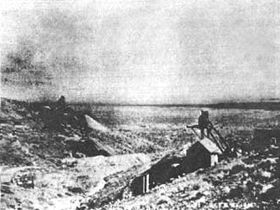
West Extension Mine, Nevada.
The mine reopened in late August and appeared to be doing well until the end of the year, when their property taxes were not paid on time. The company made more questionable financial decisions, including merging one of its subsidiary mine stocks into the parent company, announcing they would build a reduction plant that never materialized, and granting a lease on some of its mining rights to another organization. Yet, their financial reports had never looked better. By March 1908, they reported finding new ore bodies and soon had three shifts working continuously. They also began planning to construct a custom mill at Beatty. However, by fall, they had changed their minds and decided to build the mill at the mine site. As 1908 ended, the West Extension appeared to be poised on the verge of becoming one of the Bullfrog District’s essential producers. Still, with all its promise, signs of financial difficulties continued to appear in the organization.
During the first months of 1909, the ambiguity surrounding the West Extension’s future remained unresolved. In the meantime, the West Extension Mine lay idle as the directors tried to figure out what to do next, and a reported $50,000 worth of ore lay untouched on the dump. By Fall, the mine was still idle, and creditors lost patience, filing lawsuits to recover the debts. The company, in the meantime, underwent a private reorganization and replaced its president. No reason was given for the change of leaders. The Bullfrog Miner expressed the public’s bewilderment at the strange lack of action at the West Extension, for according to the company’s reports, it could easily liquidate all debts merely by shipping the ore it said was ready on the dump. Still, nothing happened.
By the end of 1909, the inevitable result was becoming plain for all to see. The Mining World assessed the West Extension as a promising property, but “one in which lack of ample capital is holding back work, while the absence of milling facilities is keenly felt. Much of the ore on this and other properties are too low to warrant shipping to smelters.”
By 1910, the West Extension appeared to be a dead mine, but the local folk refused to let it die in peace, as admitting that the West Extension, one of the latest mines of promise, had failed would be to admit the same for the entire district. But, 1910 ended the way it had begun — with no work being done on the property. By April 1911, plans were underway to auction the West Extension estate to satisfy its creditors’ claims. But in December, the Mayflower Leasing Company executed a long-term lease with the West Extension and bought the mine outright the following January. In the meantime, the old owners could only watch as their shares were sold at auction to satisfy their debts. The Mayflower began production and soon began making regular bullion shipments. However, the ore was depleted by the next year, and the West Extension Mine was shut down.
It was then idle until 1929, when it and the Original Bullfrog Mine were bought, sold, leased, and operated intermittently through 1978, though there was never again any significant production.
Despite its longevity, the remains of the mine are scant and indistinguishable from those of the Original Bullfrog Mine, especially since the two were owned and operated as one beginning in the 1930s. However, dotting the area are the remains, including shafts, dumps, and collapsed timber.
©Kathy Alexander/Legends of America, updated November 2025.
Also See:
Nevada Death Valley Ghost Towns
Rhyolite, Nevada – Little More Than a Memory
See Sources.

